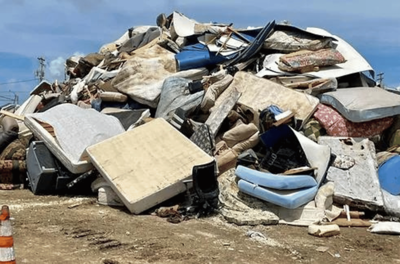GUAM (Pacific Island Times) — Within days after the strongest typhoon in 20 years hit Guam, towers of debris piled up to a point where disposal and full cleanup could stretch well beyond 2023.
A sprawling area at Tiyan that used to host carnivals, Covid-19 testing and other community events has become a disposal site for remnants of houses, from tin roofs and woods to mattresses and refrigerators, in the wake of Typhoon Mawar. Two other disaster debris disposal sites were designated, along with green waste disposal sites in 19 villages.
These towers of debris have become a daily reminder of what residents lost in the typhoon.
Guam is now grappling with the tremendous task of disposing of massive debris left behind by Typhoon Mawar. It becomes even more of a challenge because there’s nowhere to put it all in.
There’s only enough landfill space, there's a lack of household hazardous waste disposal sites, the few recycling facilities still must ship most of it off island for actual recycling, and mulching of enormous volumes of green waste would take time, among other things, officials said.
“The volume is huge but it’s not necessarily surprising. Keep in mind that we haven’t had a typhoon this strong in about 20 years,” said Peggy Denney, administrator of i*Recycle on Guam and board secretary of the Guam Solid Waste Authority. “There’s an incredible amount of damage to the natural vegetation.”
Mawar is the strongest typhoon to hit Guam in 20 years, uprooting and shredding trees, damaging mostly tin-and-wood houses and rendering most of the island without power, water and telecommunication services. It clipped Guam’s northern part on May 24 as a Category 4 typhoon with maximum sustained winds of 130 to 140 miles per hour.
Then there are old appliances and old personal belongings that residents just haven’t gotten around to letting go of for years and even decades until Mawar hit.
“People held on to it. People held on to plastic toys, old tires, old refrigerators and other appliances, white goods. So we know it’s not all typhoon debris. It’s not a criticism, it’s just kind of a reality,” Denney said. “Unfortunately, much of it will end up in the landfill.”
Irvin Slike, general manager of the Guam Solid Waste Authority, told the board in June that Layon landfill’s cell No. 3 should be able to take in tons of Mawar debris.
“Luckily it happened at a good time because the landfill was opened in July of 2021, roughly a seven- to eight-year lifespan in cell 3. So we’ve got time to absorb this tonnage,” Slike said. “It would have been much worse had it been towards the end of the life of a cell. But this is okay.”
But it’s still too early to tell how exactly the typhoon debris could shrink the expected lifespan of the existing landfill cell. Mawar’s impact will also be considered in the planning of Layon landfill’s cell number 4, Slike said.
Within two weeks after Mawar, the volume of trash that GSWA picked up from residential areas was up to three times the normal tonnage, Slike told the board during their first meeting since the typhoon hit.
Average trash tonnage over a two-week period prior to Mawar was 900 tons, but GSWA picked up more than 2,720 tons in two weeks post-typhoon, Slike said. GSWA’s three residential transfer stations used to get 5,503 cubic yards of trash every two weeks but this jumped to 15,843 cubic yards within two weeks after Mawar.
Landfilling is just one of three ways to properly dispose of the “estimated hundreds of thousands of cubic yards of debris,” said Nic Rupley, spokesperson for Guam Environmental Protection Agency.
Debris will also be brought to local recycling facilities, although there’s only so much that can be recycled. The third way is to ship debris off-island, especially household hazardous waste because there’s no facility on Guam to dispose of it, Lee said.
Local and federal government officials, as of this writing, still do not have estimates of just how much trash Mawar left behind.
In July, the U.S. Army Corps of Engineers, at the request of the Federal Emergency Management Agency, started assessing the amount and types of debris, which will then be collected if it is determined eligible debris. It includes vegetation debris; mattresses, couches and other household furnishings; large appliances; construction and demolition debris; ferrous, metals, cans and tin.
For so-called ineligible debris such as tires, electronics and household hazardous waste, processing and disposal are handled by other local and federal entities such as the U.S. Environmental Protection Agency and its contractors.
Guam EPA received $5 million to properly dispose of household hazardous waste such as cleaning products, batteries, thinners and oils, fluorescent bulbs, and toxic refrigerants or freon from refrigerators, air conditioners and other white goods, Lee said. The work includes categorizing, processing and shipping this household hazardous waste off-island for proper disposal.
Given the enormous amount of waste that Mawar left behind, it would take “several months” to dispose of all of it, Lee said.
Unlike illegal dumps, there’s segregation and organization that have gone to the designated disaster debris disposal sites at Tiyan, Tamuning and Dededo.
At Tiyan, for example, wooden construction materials take up one area, old mattresses and couches are piled up in another, while televisions, computers, toasters, microwave ovens, old washers and dryers, bicycles and old kitchen gas tanks all have their own spaces.
Public Works Director Vince Arriola told senators that the typhoon cleanup could take several months, or up to 2024, to complete.
“I can see ourselves going maybe another eight to 10 months of cleaning the island. I think it’s going take that long,” Arriola said at a DPW budget hearing that covered the agency’s role in typhoon response and recovery.
Federal agencies and private contractors have been aiding in the assessment, removal, cleanup and disposal since there’s not enough expertise and manpower on the island.
Arriola and Denney said green waste – which has since dried out and turned brown – will be mulched and burned using air curtain burners. Ash could then be used by farmers, while mulched materials could be used by farmers and residents. Given the enormous green waste from Mawar, burning and mulching would take a long time.
Sen. Roy Quinata, who heads the legislative committee with oversight of the Department of Public Works, said it’s commendable that the government provided disposal sites for typhoon debris as the community recovers from Mawar, but it also needs to prevent more illegal dumping that would pose health and safety hazards.
Long before Mawar, there were already illegal dumps throughout the island. But it got worse after the typhoon, Quinata said at the DPW budget hearing. “There’s a lot of debris that had nothing to do with Mawar,” he said, adding that illegal dumping has become “ridiculous.”
Gov. Lou Leon Guerrero has allocated $9 million in the federal American Rescue Plan funding for universal trash collection, but that has since been reduced to $7.3 million. There is no telling when this trash collection service for all will get off the ground.
Guam’s debris or trash challenges could get worse if another powerful storm hits the island, considering the National Weather Service’s forecast that the region can expect two to four more typhoons before the year ends.
“Whether the next one is stronger or weaker than Mawar, typhoon preparations should remain the same,” Lee said. “Start securing loose items or dispose of them ahead of the storm, in addition to filling your gas tank.















